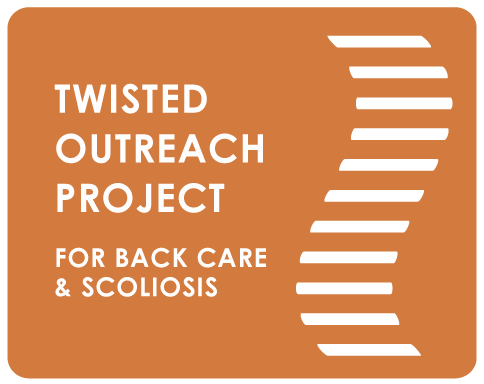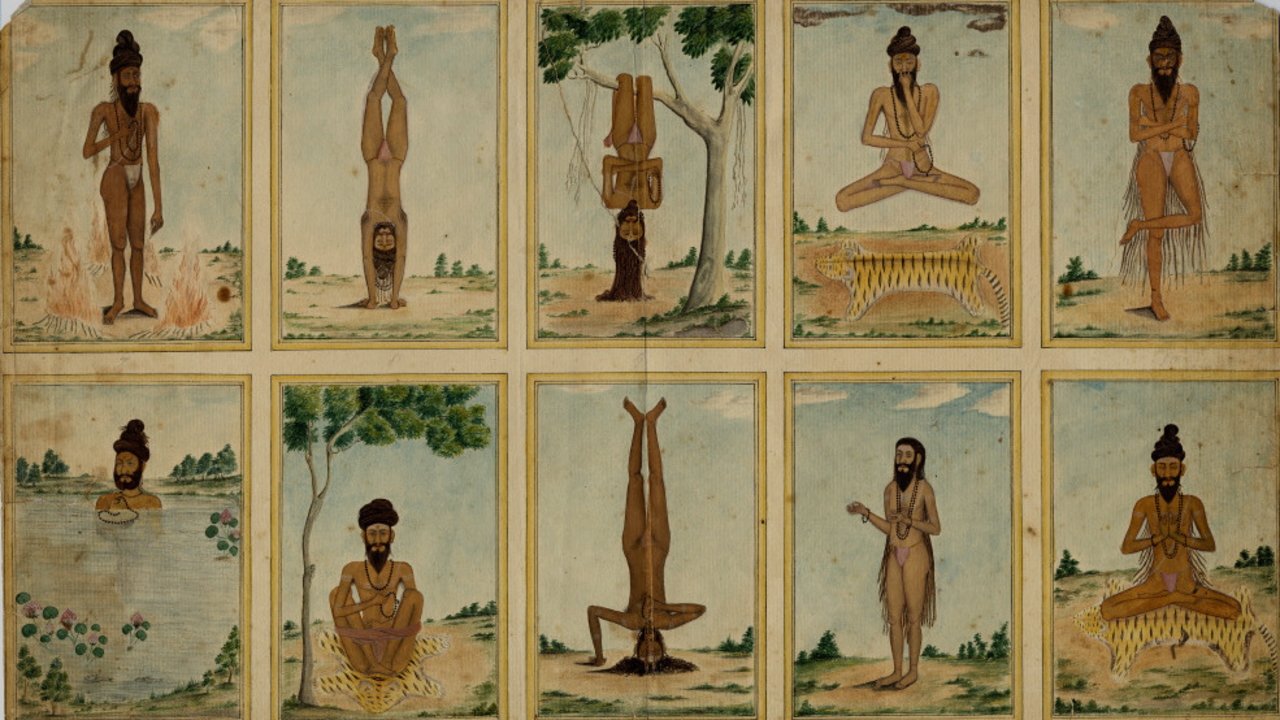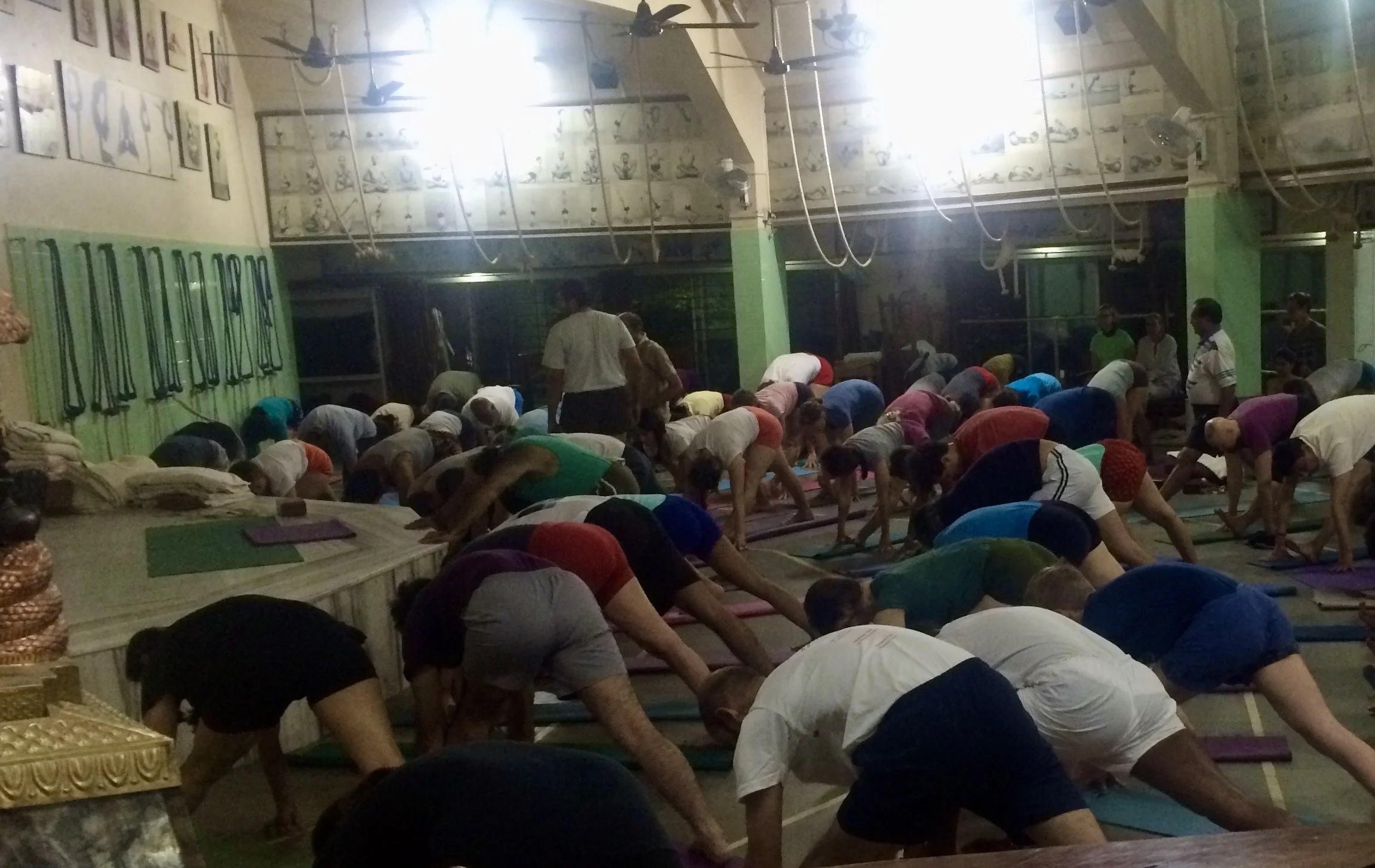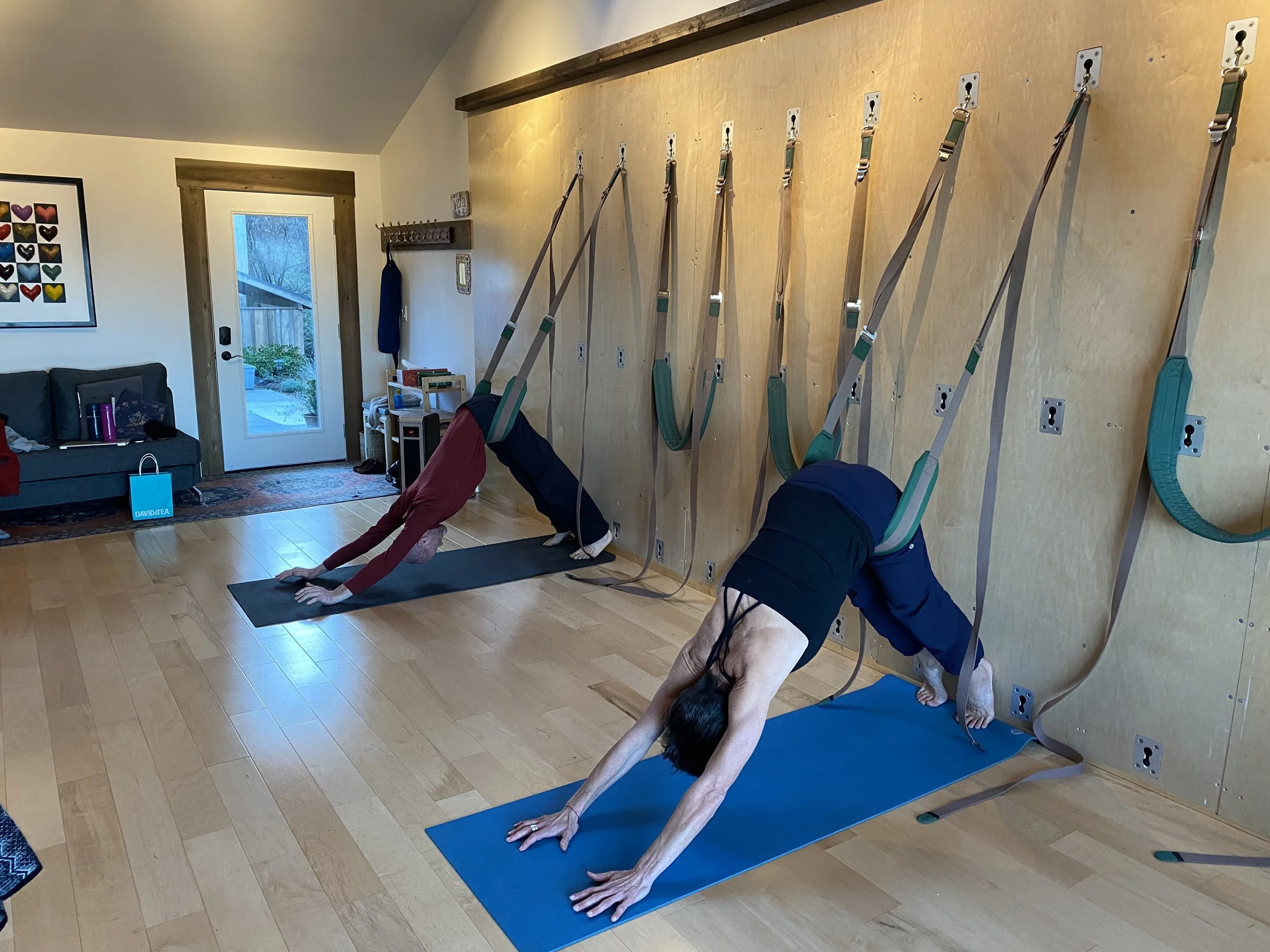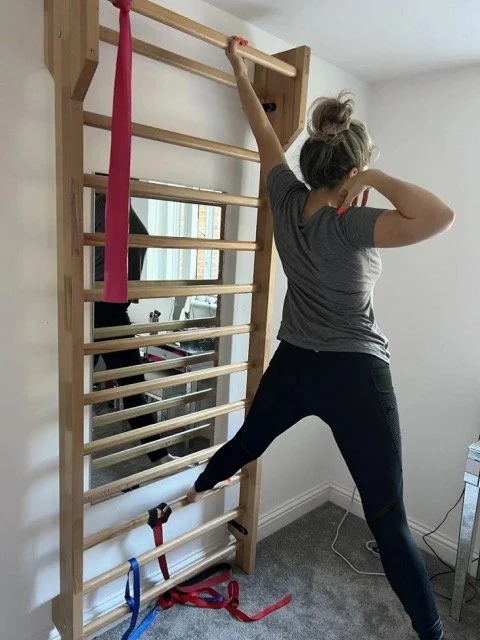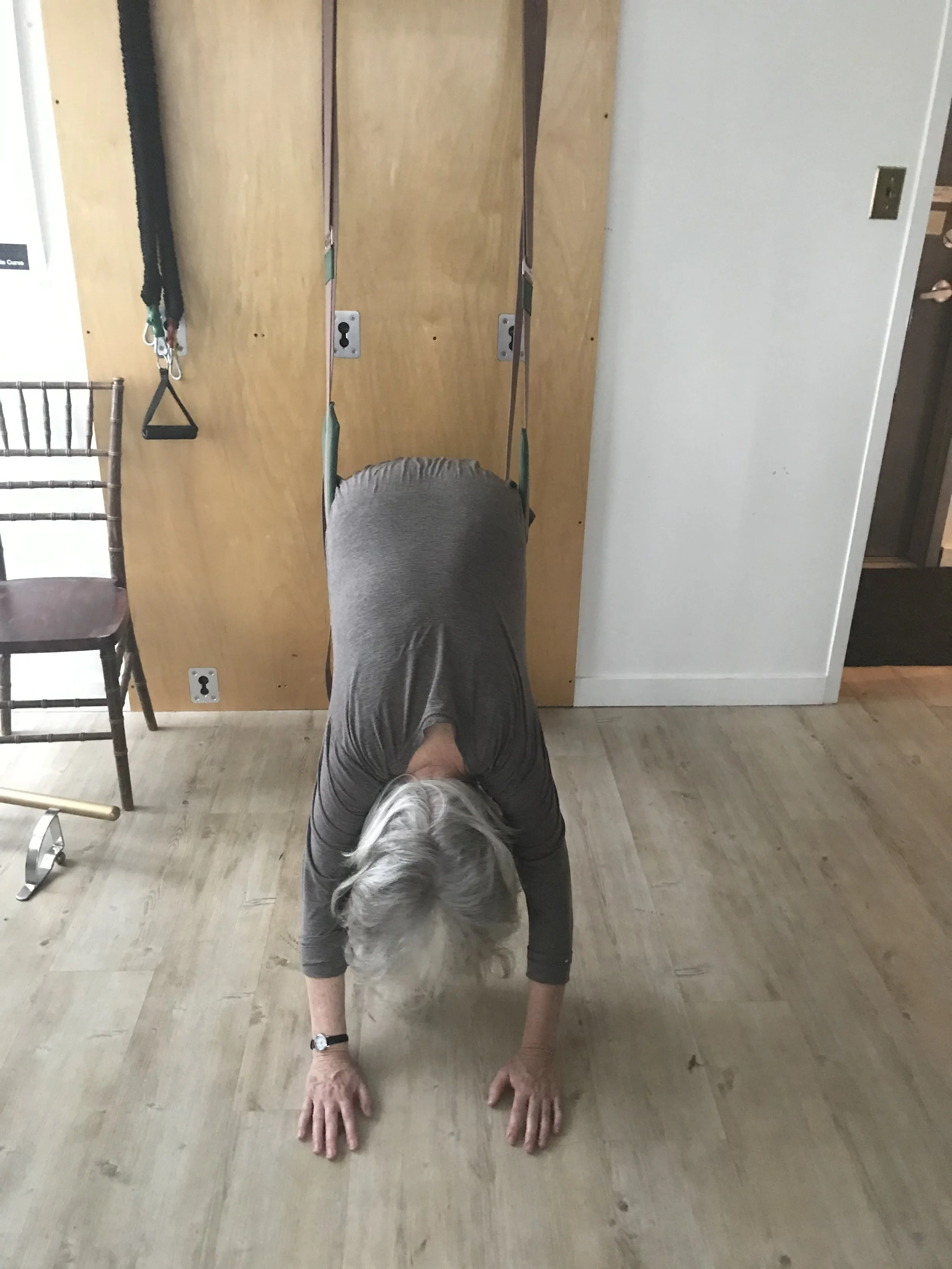Using The Iyengar Yoga Wall To Enhance Your Practice
This is Part 49 of a serial blog originally titled 'Martha Carter's Healing Journey'. Curious about the earlier posts? To start from the beginning, read Part 1.
***
“Be cautious, be bold!” - B. K. S. Iyengar
Intro
In 2009, I was first introduced to the benefits of working with a yoga wall at the Yoga Union studio in New York City. I was taking a 'Yoga for Scoliosis’ workshop there with specialists Deborah Wolk and Elise Browning Miller and we used the wall several times over the weekend. It was fascinating and fantastic. I was immediately intrigued. Since then, that studio has changed its location and its name - it is now called Samamkaya Yoga Backcare and Scoliosis Collective - but their traditional yoga wall moved with them and currently covers two sides of their bright, welcoming studio.
Drawing of ancient yogis using nature to support their practice
ABOUT THE TRADITIONAL IYENGAR ROPE WALL
The "Iyengar yoga wall," more formally known as the yoga rope wall, was developed by B. K. S. Iyengar in the late 1960s and early 1970s. He was inspired by the ancient yogic tradition of using natural elements like vines and tree limbs for support and traction, which he formalized into a system of ropes anchored to wall hooks. Iyengar referred to this practice as "yoga kurunta" or "yoga puppetry," using the ropes to assist in deep stretches and inversions, allowing students to explore alignment and body positioning in new ways.
This traditional wall system is quite labour intensive to build and use. It requires covering a regular wall with plywood panels where metal hooks that look like drawer pulls are attached. Tied around the hooks are white ropes that remind me of something a sailor might use on a boat, all configured into specific lengths and loops that can be untied and re-tied in various ways. There are usually 3-5 levels of hooks to allow for different experimentation at different heights.
Traditional wall ropes in the RIMYI studio in Pune, India.
This is the kind of rope wall I first tried at Yoga Union. In fact, this is the type of wall I have experienced, over the past 15 years, in all the serious Iyengar yoga studios I have ever trained in, including Yoga Union/Samamkaya in NYC with Deborah Wolk, Yoga del Pacifico in Troncones, Mexico with Zoreh Afsarzadeh, the California Yoga Studio in Palo Alto with Elise Browning Miller, Yoga Space in Vancouver with Louie Ettling, Ganges Yoga Studio on Salt Spring Island, Bend Over Backwards studio with Kelly Green in Nanaimo and, of course, at the mothership studio, the Ramamani Iyengar Memorial Yoga Institute (or RIMYI) in Pune, India.
Traditional rope wall in the Samamkaya studio, NYC.
Rope walls are standard in the world of Iyengar yoga, and I was happy to find them everywhere I went. Learning how to use them rocked my world for the better as they allowed me to discover new length, strength, support, and freedom throughout my body. I learned that, although there are many recommended poses, each person can be creative and play with the ropes in whatever way best supports their particular body type and physical limitations. At first, I was extra nervous because of my fused spine, but as I became more comfortable, I realized that the wall facilitated me to finally explore inversions without having to put weight on my head. That was one of many exciting discoveries.
As Mr. Iyengar said, “Be cautious, be bold!”
!CAUTION!: Speaking of cautious, inversions on the rope wall can be transformative, however, inverting can be tricky for people with certain medical conditions and is not recommended during menstruation. For anyone interested in trying them, regardless of the kind of wall, it is advised to take it slowly and cautiously, and to ideally take instruction from someone who can teach how to use it safely.
A MORE MODERN VERSION: THE GREAT YOGA WALL
Great Yoga Wall in Martha’s garage studio
Strangely, the rope wall system has never become common in other kinds of yoga and exercise systems, even though it would definitely be a positive addition to any wellness facility. However, in 1998, an American company called The Great Yoga Wall, created a new, more modern (and more comfortable) version of the rope system. Instead of using ropes tied to hooks, specific hardware is embedded into customized plywood panels that are then screwed into the wall. Instead of the stiff, white sailor ropes, there is a ‘wall plate and ball’ strap system where straps can be popped in and out of the wall without having to untie anything, allowing for more convenience. These straps can also be shortened and lengthened with a buckle, and they can also be attached to a wider, cushioned piece, creating a ‘pelvic swing’ for supported hanging. In general, it is a much more comfortable setup to use than the original Iyengar wall, however, for the seasoned connoisseur, nothing compares to Iyengar’s brilliant invention.
Schroth wall bar equipment.
Over the last little while, I have been finally seeing yoga walls in various non-Iyengar studios including Naada yoga in Montreal and OM PREM in West Vancouver to name two. I suspect that comfort, combined with convenience, has made the concept of working with ropes through The Great Yoga Wall system attractive to a whole new generation of yogis and body workers. In my case, as soon as I discovered this more ‘cushy’ version around 2010, I couldn’t get enough of it. Although I did get used to working with the traditional wall over time, I never felt completely relaxed as the ropes would dig into my skin. But the new, wide and soft pelvic swing gave me confidence to let go, giving me a new appreciation of how the support let me lengthen more deeply, without worrying about gravity - or the discomfort of the ropes digging in. Along with the inversion and other ‘hanging’ poses, I also learned how working with the wall supports and helps to improve awareness of standing poses, contributing to improved alignment, balance, and spatial awareness in myriad ways.
And, there is good news for anyone interested in having their own wall…The Great Yoga Wall has created a ‘portable’ version of the pelvic swing that does not require the whole wall setup, so it makes it really accessible for anyone to use at home. More on that later.
On a side note, I want to point out that there is another type of wall that is commonly used for scoliosis treatment through the Schroth Method, which is a non-surgical movement technique, specifically for scoliosis, usually guided by physiotherapists. The Schroth ‘wall bar’ equipment is constructed like a wide wooden ladder and is reminiscent of some of the equipment you might see in a school gym. Working on the Schroth wall bars can definitely bring similar benefits as the yoga wall, but the big difference is that it is not focused on supporting traditional Iyengar yoga poses.
CREATING MY OWN YOGA WALL - ENHANCED YOGA FOR SCOLIOSIS
As soon as I had the opportunity, I installed a Great Yoga Wall in my own studio space on Vancouver Island, plus a small one-person panel at a Vancouver office. And similar to what happened with Yoga Union, when I was required to move from both places, I took the plywood panels and all the attachments with me to my new house, where I re-hung it in my new little garage studio that was specifically created to hold the wall. I loved it and I was obsessed.
Single panel in Vancouver office space
As I started using it regularly and sharing it with students, I quickly gained appreciation for how much people enjoyed using it - especially people with scoliosis. No matter what your level or body type, everyone can gain instant relief - lengthening - opening of their whole torso, thanks to the gentle traction provided by the rope wall.
The first position everyone wants to try is a ‘Downward Facing Dog’ with the heels on the wall, as it allows for a wonderful inversion, allowing the spine to lengthen with gravity as the head hangs towards the floor. This position takes the pressure off the vertebrae while giving the hamstrings a break. Falling into gravity and letting the traction do its thing gives immediate relief to any aching back.
My next favourite position is Uttanasa, or Forward Fold, as it continues the inverted traction for the spine while also waking up the hamstrings.
Following those foundational positions, I almost always do a chest opener and other standing poses where holding onto the straps is a fantastic way to keep the chest open and wide while also feeling secure with balance and alignment. Before I finish my practice, I love going into a full upside down hang, really letting the blood flow to my head while I feel all my internal organs shift into a new direction with the change of gravity. Eventually, I bring myself into some supported relaxation poses close to the ground. I particularly enjoy doing ‘legs up the wall’ with my back on the floor and my pelvis floating just above the floor in the swing. This takes the pressure off the lower back, encouraging full release.
And then the coup-de-grace is laying on my back on the floor in ‘Sivanasa’ or ‘corpse pose’ with my head supported by the swing, giving me the feeling that I am floating in water. It’s a wonderful sensation, especially for anyone with a sore upper back or neck area.
Over the years, I have taught several ‘Yoga Wall for Scoliosis’ workshops and I also created a small booklet of exercises to share with students. I had the full intention to do more, but when the pandemic came along in 2020, all my classes went online. The wall classes didn't make any sense to teach online as almost nobody has a yoga wall in their living room! That was the end of that for a while.
But here we are! SIX years later, and I am finally feeling passionate about the yoga wall again.
IMPROVISING YOUR OWN YOGA WALL EXPERIENCE
During a recent summer workshop in the Comox Valley on Vancouver Island with Deborah Wolk, which was held in a space with no yoga wall, we had to improvise (see photo collage below). We attached straps and plain yoga belts to posts, railings, and even the poles of a children’s playground. We hung the pelvic swings off the side of a play drawbridge so that the students could experience inversions. It was epic fun and very inspiring, reminding me that I have not been using my wall at home enough!
PORTABLE ‘HOME VERSION’ of the GREAT YOGA WALL
As briefly referred to earlier, alongside the option of improvising with yoga belts on playgrounds, The Great Yoga Wall company has created a version of their pelvic swing which they call a ‘regular wall swing’ with carabiners at the ends that can either be attached to hooks screwed into any wall or structure, or attached to ‘over-the-door’ straps that get closed tightly into a door frame in your home or office. This set up also allows the swing to be used easily while traveling. Options!
Speaking of options… (and if you want to purchase your own wall)
NEW VIDEOS - NEW BOOKLET - NEW WORKSHOPS
So now that my passion for sharing the Yoga Wall has returned, TOPS and I are in the process of creating a series of instructional videos where I demonstrate 12 different ways to lengthen, strengthen, and stabilize the body with the support of the wall - whether you are using an official setup in a studio, or an improvised version at home. We are also creating a booklet to accompany the videos.
For anyone in the USA or further afield interested in purchasing any version of The Great Yoga Wall, you can find building instructions, the hardware, and all the equipment on their website at https://yogawall.com/
For people who live in Canada who are interested in the portable home version, you can purchase them through our TOPS website shop; they have already passed through international shipping procedures, including customs, duties, etc.
And stay extra tuned for upcoming Yoga Wall workshops in Vancouver and Courtenay in 2026!
‘Yoga Wall for Back Care and Scoliosis’ Workshop
With Martha Carter
April 2026
Greater Vancouver, BC
‘Somatic Solutions for Scoliosis and Fusions’ Retreat
With Martha Carter
May 8-11 2026
Vancouver Island, BC
***
Interested in receiving our monthly newsletter? Subscribe here.
Got comments? Please feel free to write us anytime.
